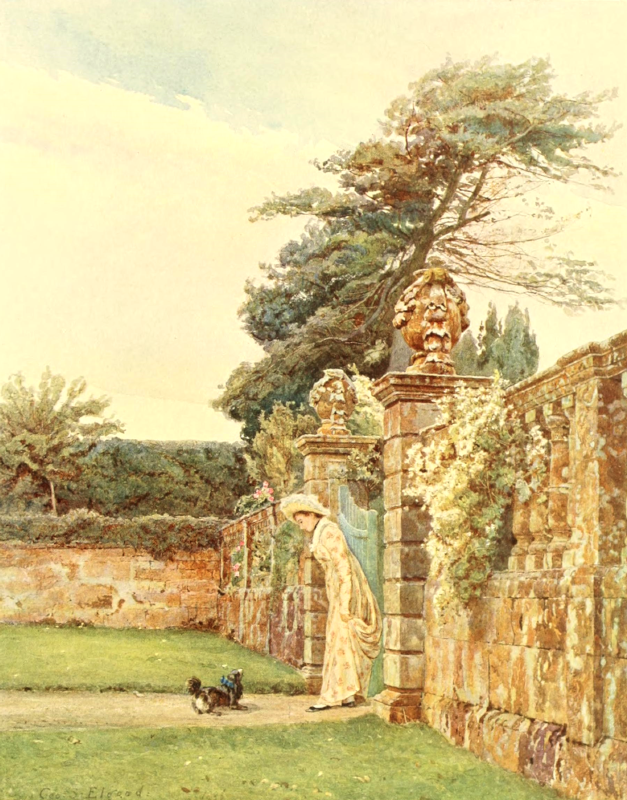| Web
and Book design,
Copyright, Kellscraft Studio 1999-2021 (Return to Web Text-ures) |
 (HOME)
|
|
BRYMPTON
Brympton
d'Evercy in Somersetshire — not far from Montacute, the residence of the Hon.
Sir Spencer Ponsonby-Fane — is a house of mixed architectural character of
great interest. A large portion of the earlier Tudor building now shows as the
western (entrance) front, while, facing southward, is the handsome façade of
classical design, said to be the work of Inigo Jones, but more probably that of
a later pupil. The balustraded wall flanking the entrance gates — the subject
of the picture — appears to be of the time of this important addition, for it
is better in design than the balustrade of the terrace, which was built in the nineteenth
century. But
the terrace is of fine effect, with the great flight of steps midway in its
length that lead down to a wide unspoilt lawn. This again passes to the
fish-pond, then to parkland with undulating country beyond. The
treatment of the ground is admirable. Fifty years ago the lawn would probably
have been cut up into flower-beds, a frivolity forbidden by the dignified
front. Gardening is always difficult, often best let alone, in many such cases. When the architecture, especially architecture of the classical type, is good and pure, it admits of no intrusion of other forms upon its surfaces. It is complete in itself, and the gardener's additions become meddling encroachments. When any planting is allowable against houses of this type — as in cases where they are less pure in style and have larger wall-spaces — it should be of something of bold leafage, or large aspect of one simple character; the strong-growing Magnolia grandiflora as an upright example, and Wistaria as one of horizontal growth. There is some planting between the lower windows at Brympton, but it is doubtful whether it would not have been better omitted. It is a place more suitable (if on this front any gardening is desirable) for the standing of Bays or some such trees, in tubs or boxes on the terrace.  From the picture in the possession of Mr. Edwin Clephan There
is sometimes a flower-border at the base of such a house; where this occurs it
is a common thing to see it left bare in winter and in the early year dotted
with bulbous plants and spring flowers; to be followed in summer with
bedding-plants. No such things look well or at all in place directly against a
building. The transition from the permanent structure to the transient
vegetation is too abrupt. At least the planting should be of something more
enduring and of a shrubby character, and mostly evergreen. Such plants as Berberis
Aquifolium, Savin, Rosemary and Laurustinus would seem to be the most
suitable, with the large, persistent foliage of the Megaseas as undergrowth, Pyrus
japonica for early bloom, and perhaps some China Roses among the Rosemary. But
happily this house has been treated as to its environment with the wisest
restraint. No showy or pretentious gardening intrudes itself upon the great
charm of the place, which is that of quiet seclusion in a beautiful but
little-known part of the county. The place lies among fields — just the House,
the Church and the Rectory. There is no village or public road. The house is
approached by a long green forecourt inclosed by walls. Between this and the
kitchen garden is the quiet, low, stone-roofed church, in a churchyard that
occupies such another parallelogram as the forecourt. The pathway to the church
passes across the forecourt into the restful churchyard with its moss-grown
tombs and bushes of old-fashioned Roses, and the grassy mounds that mark the
last resting-place of generations of long-forgotten country folk. The
church has a bell-cote built upon the gable of its western wall of remarkable
and very happy form, stone-roofed like the rest. Among the graves stands the
base — three circular steps and a square plinth — of what was once an ancient
stone cross. The church seems to lie within the intimate protection of the
house, adding by its presence to the general impression of repose and peaceful
dignity. The picture shows the walled and balustraded entrance, probably contemporary with the classical façade, wrought of the local Ham Hill stone; a capital freestone for the working of architectural enrichment. It is of a warm yellowish-brown colour; but grey and yellow lichens and brown mosses have painted the surface after their own wayward but always beautiful manner. A light cloud of Clematis Flammula peeps over the bushes through the balusters. Stonework so good as this can just bear such a degree of clothing with graceful flowery growth; no doubt it is watched and not allowed to hide too much with an excess of overgrowth. Where garden architecture is beautiful in proportion and detail it is not treating it fairly to smother it with vegetation. How many beautiful old buildings are buried in Ivy or desecrated by the unchecked invasion of Veitch's Virginia Creeper! |